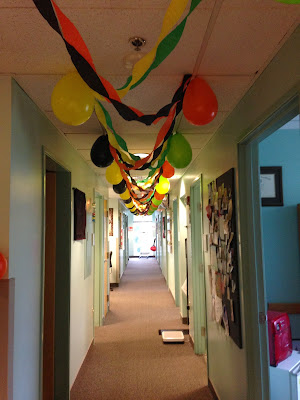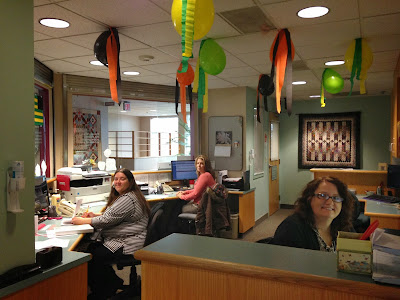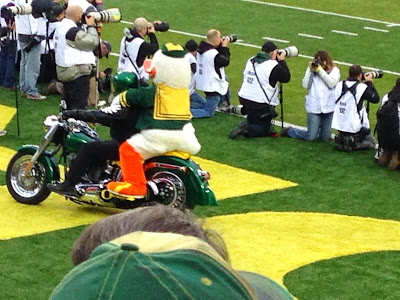 |
| done done done!!!! YES!!! |
 |
| Very green on the back |
 |
| I did very large wavy cross hatch quilting so that it maintained it softness as we will be using this quilt in the living room. |
 |
| The design is from an American Civil War cot quilt. I started the quilt in 2011 to hang at work next to an Oregon Beaver quilt made by my manager. The first year my "quilt" hung as a quilt top. Last year it was half quilted. This year, it is completely done including the label and hanging sleeve!!! |
When I get a quilt done, there is still the binding to hand sew down to the back, the sleeve to sew on and the label to make and sew on. I decided to do it a little different on this quilt.
Hanging Sleeve and Quilt Label
If you are going to put your quilt in a show, the one requirement that most shows have is having a 4" hanging sleeve attached to the back.
My sleeves have morphed over the years, and I think I am finally happy with the design I currently use. I added a quilt label to this hanging sleeve which really saves a lot of time for me!! This is what I do/did.
Hanging Sleeve and Quilt Label
Measure across the top of the quilt where the hanging sleeve will reside.
Subtract 2 inches-this will be the length of your unfinished sleeve.
Make your sleeve: Quilt top width minus 2" X 9 & 3/4" (I like my sleeves to be a little larger than 4" )
If you decide to put your label into the sleeve, adjust your measurements. My label was 4.5" X 3.5" So my sleeve length needed to be:
Quilt top length minus 2" = A
A minus 4.5"- (label width) = B
B + 1" for seam allowance = C-length needed for hanging sleeve
You also need a strip of the hanging sleeve fabric the same width as your label.
 |
| Cut a section the same width of your label. Cut off 1.25" of the top |
 |
| Sew the sections together. |
 |
| Decide where on the hanging sleeve you want your label, cut , and sew the sections back together. |
 |
| Hanging sleeve ready for construction!! |
 |
| On each short end, fold in 1/4" and press |
 |
| Fold again and press |
 |
| Stitch seams down |
 |
| Fold in half lengthwise and press. |
 |
| All pressed and ready to be attached to the quiilt. Maddie is so very impressed!!! |
 |
| Once I'm at the point of putting the hanging sleeve on the quilt, I pin it down on the back, then continue with my application of the binding on the front. That way the sleeve is a part of the whole quilt and cannot be removed very easily. Plus, it gives you a very sturdy hanging sleeve. |
 |
| Binding all hand sewn to the back and now it is time to sew the hanging sleeve down. |
 |
| I first pin the edge of the underneath side down, leaving the top free. You are actually making a tube now so that when you put a stick or rod, in you will not damage your quilt or quilting. |
 |
| Pinned and ready to hand stitch. Notice that my pin on the left is at the 1/4" mark. I will stitch up to that point. |
 |
| Hand stitching. I am a lefty!! Enough said!! |
 |
| At the 1/4" mark, I make a good knot to keep that point secure. Then I pull back on the sleeve. Notice how you can see the crease? I will pull the sleeve back the entire length using the crease to help me measure 1/4". |
 |
| Pin. |
 |
| Notice the 1/4" crease? |
 |
| And notice that the sleeve is not laying flat? This is what will give you space for a hanging rod and not contort your quilt. |
 |
| Hanging rod tunnel!! |
 |
| Label done and not easily removed!! And no handstitching the label on!!! YES!! |
 |
| A little different than most quilt labels, but easier and a bit more permanent!!! |
 |
| Maddie approves!!! |
Take care, Happy Quilting and I hope I didn't confuse anyone!!?? If so, let me know and I will try to re-clarify my instructions!! Martha
Oh, and keep those scissors sharp!!!

































































